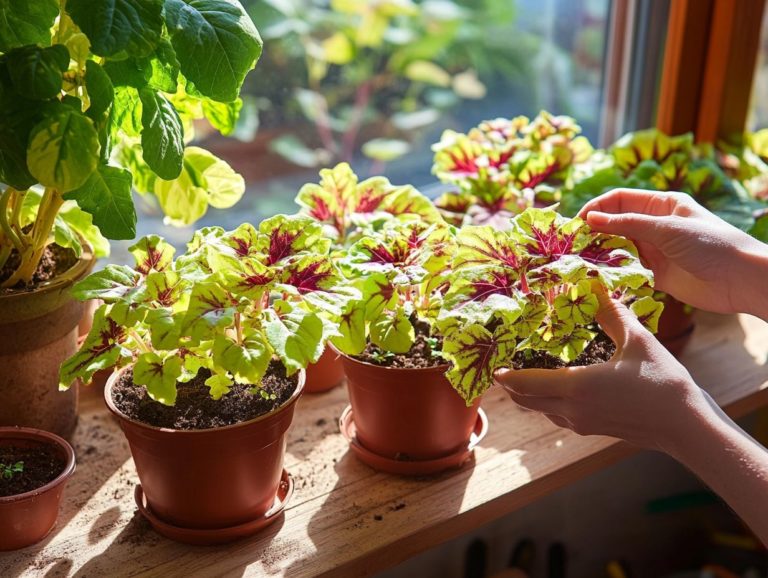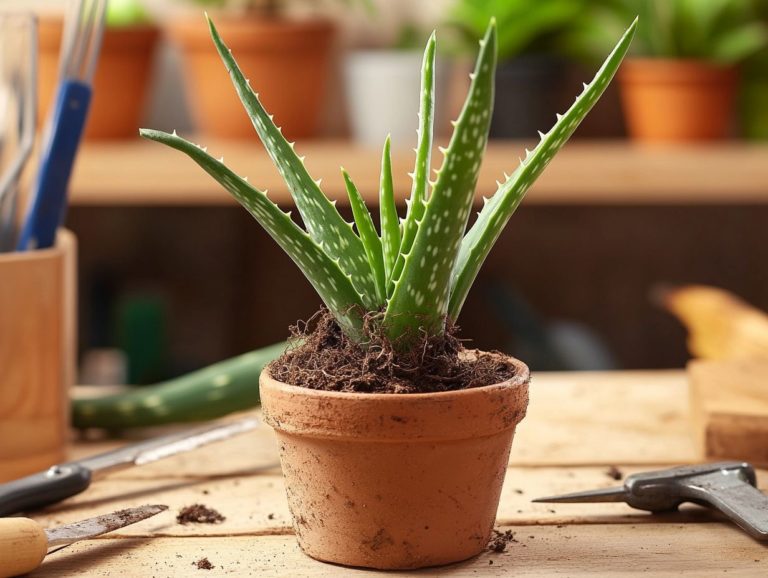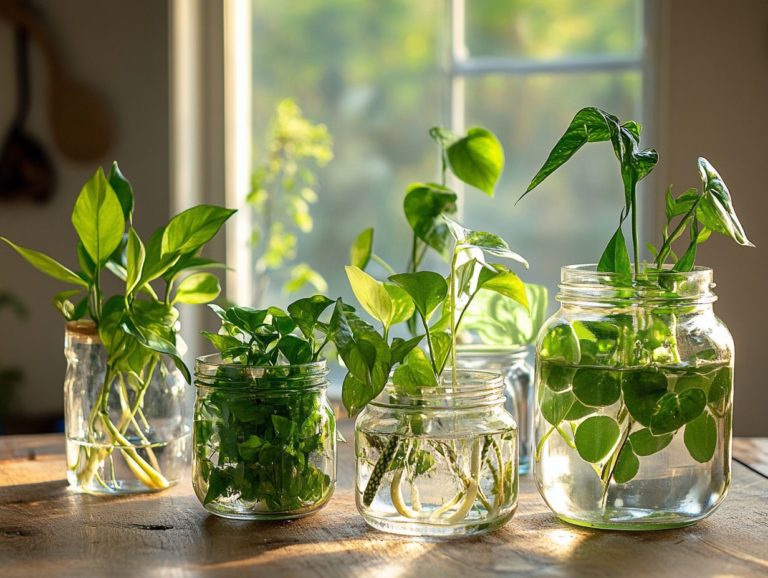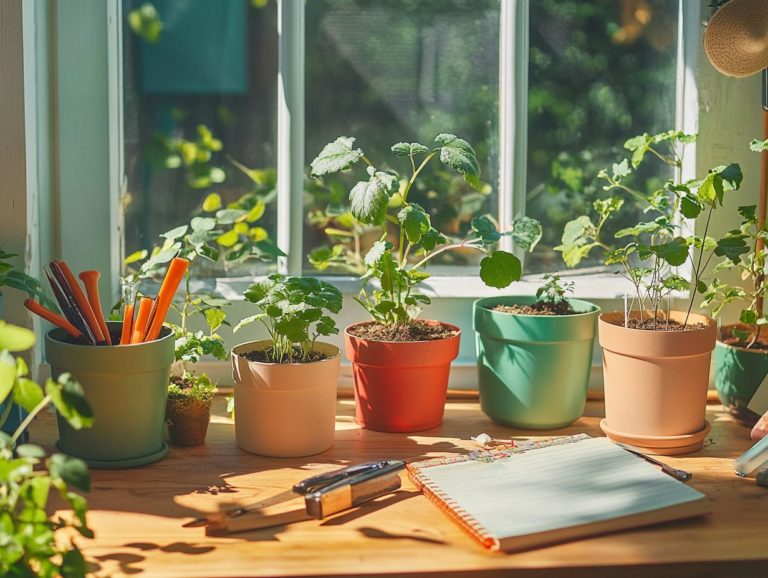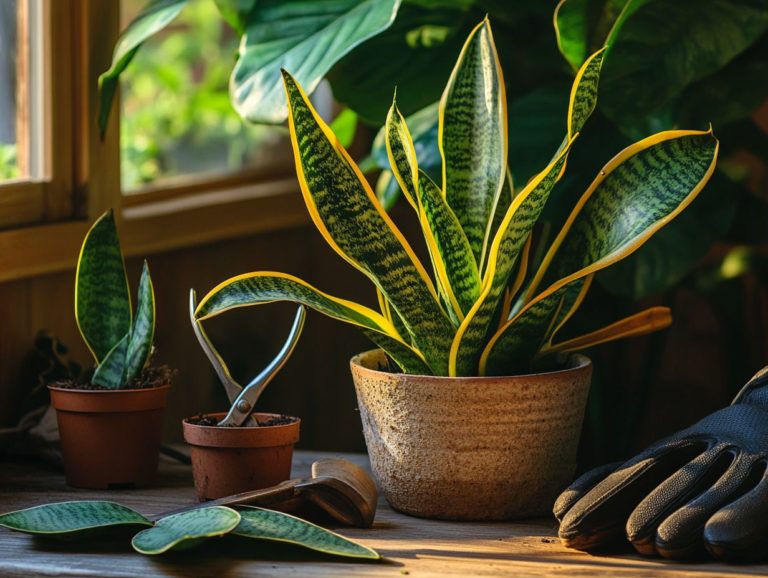How to Propagate Your Favorite Vines
Are you prepared to breathe new life into your garden by propagating your favorite vines? Whether you re an experienced gardener or just dipping your toes into the world of plants, mastering the art of propagation can truly transform your gardening experience.
This guide will walk you through the essentials, from selecting the ideal vine to evaluating important factors and employing various propagation techniques like seeds, cuttings, and layering. You ll discover practical tips on preparing your materials and crafting the perfect environment for growth. Start this exciting journey now and watch your garden flourish!
Contents
Key Takeaways:
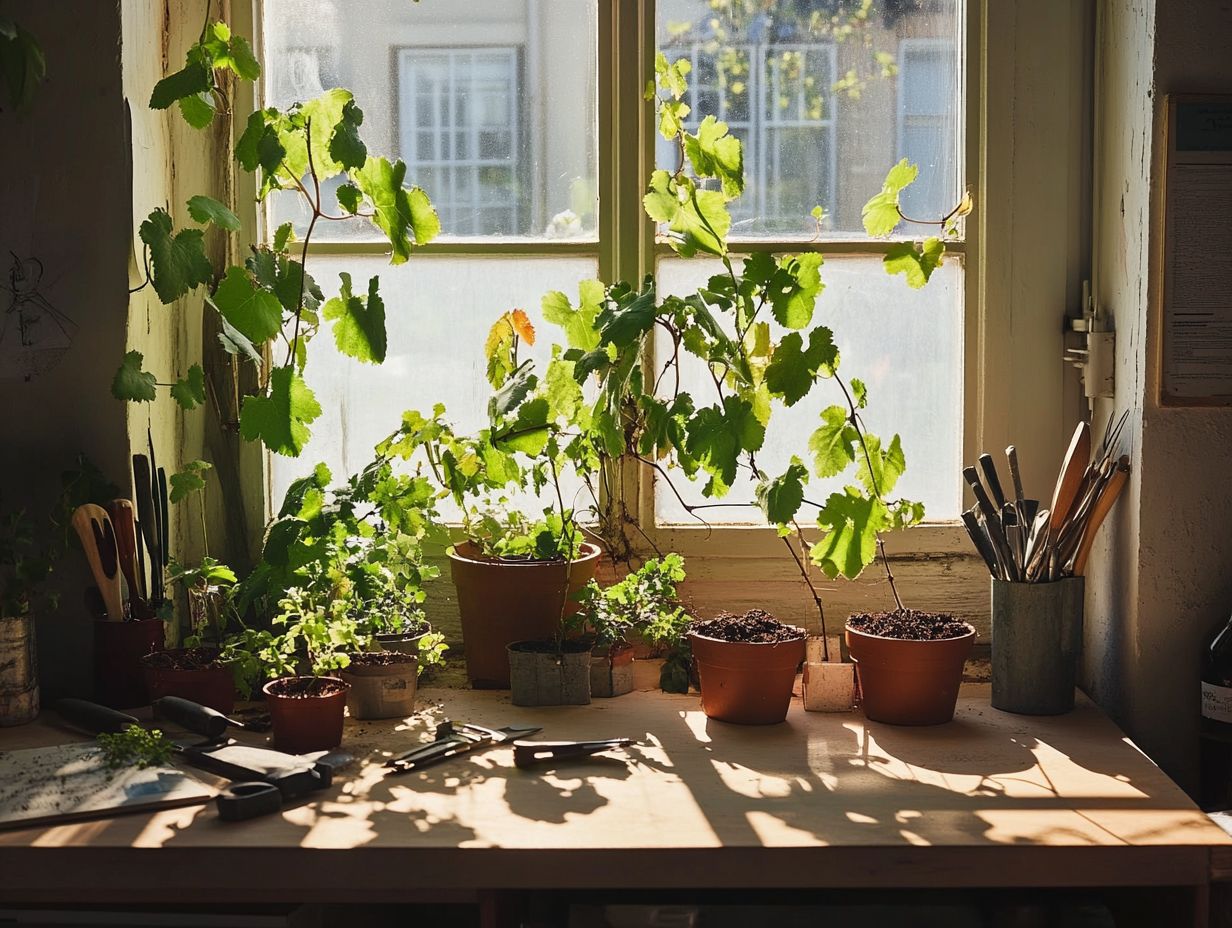
- Choose the right vine for propagation by considering factors such as climate, soil, and sunlight.
- Prepare for propagation by gathering materials and creating a suitable environment for the vines to thrive.
- Follow a step-by-step guide for the method of propagation you have chosen, whether it be seed, cutting, or layering.
What is Propagation?
Propagation is the art of creating new plants from existing ones. You can explore various methods like water propagation, seed sowing, or using cuttings from beloved houseplants such as Pothos, Philodendron, and ZZ plants.
Engaging in this practice not only sharpens your plant parenting skills but also enables you to share vibrant, healthy plants with fellow enthusiasts, enriching the community of plant lovers.
When you grasp the nuances of propagation, you enhance root growth, ensuring that each new plant flourishes in its environment. By diving into techniques like division, layering, and grafting, you can select the method that best suits the specific types of plants you re working with and their unique needs.
A solid understanding of these propagation strategies nurtures healthier botanical life and helps you avoid spreading invasive or toxic species, which can complicate your propagation endeavors. Being aware of the risks posed by plants that emit harmful chemicals is essential for your safety, allowing you to approach propagation with a sense of mindfulness and responsibility.
Ultimately, mastering these diverse methods paves the way for a more thriving indoor garden, where each plant coexists in harmony, creating a flourishing ecosystem.
Choosing the Right Vine for Propagation
Selecting the ideal vine for propagation is important, particularly with varieties such as holiday cactus and grapevines, which can produce breathtaking results in both indoor and outdoor settings.
It s vital for you to do some research on which types are best adapted to your particular climate and care regimen. Factors like soil type, moisture levels, and local agricultural guidelines can profoundly influence your success.
Connecting with local cooperative extensions or agricultural universities can provide valuable insights into the most appropriate grape varieties and vines for propagation in your area.
Factors to Consider
When you’re diving into propagation, a few key factors are crucial for your success. Moisture levels, soil quality, and the specific types of plants you re working with especially toxic varieties that need extra care play a vital role.
Understanding how to balance these components is essential for nurturing healthy plants and promoting robust root growth. Each variety, whether it s a houseplant like the ZZ plant or a more exotic option, requires your attention to these details if it s going to thrive.
Moisture retention is particularly critical; it not only aids plants in absorbing essential nutrients but also alleviates stress from drought-like conditions. Similarly, soil pH, or the acidity or alkalinity of the soil, can significantly affect nutrient availability, making regular checks and adjustments necessary for optimal growth.
Being aware of any toxic plants nearby is equally important to prevent accidental harm, especially if pets or small children are around. All these elements weave together to create a complex tapestry that influences overall plant care, urging you to stay vigilant in monitoring your plants’ environments for the best possible outcomes.
Ready to get started? Gather your materials and let s grow!
Methods of Propagation
Get ready to grow your garden! You have a wealth of popular propagation methods at your fingertips, each offering unique advantages and techniques. Water propagation and the cutting method are particularly favored in nurseries for houseplants like Pothos and Philodendron.
By grasping these methods, you can effectively generate new plants while promoting optimal root growth and health. Mastering these techniques not only allows you to expand your collection but also opens the door to participating in local plant swaps, where you can share your thriving plants with fellow gardening enthusiasts.
Seed Propagation

Seed propagation is an essential method for cultivating new plants by sowing seeds. This allows you to grow a delightful array of species, including various grape varieties, right from the beginning.
This approach demands a keen understanding of the conditions for seeds to grow think temperature, moisture, and soil composition to nurture healthy plants. Choosing high-quality seeds and providing them with the proper care is key to achieving a successful outcome.
To kick things off, prepare the soil meticulously. Ensure it s well-drained and packed with nutrients, often achieved by incorporating organic matter like compost.
Once the seeds are in the ground, keep a close eye on moisture levels; consistent watering is critical during the germination phase. Some grape varieties prefer specific climates.
For instance, Cabernet Sauvignon tends to thrive in warmer regions, while Riesling is more at home in cooler areas. As your seedlings emerge, remember that patience and careful monitoring are paramount.
These young plants are delicate, so providing the right light and temperature will set them on the path to thriving.
Cutting Propagation
Cutting propagation is an elegant technique that allows you to take a section of a plant like a stem or leaf and encourage it to grow roots, forming a brand-new plant. This method shines particularly bright for houseplants such as Pothos and Philodendron.
By utilizing rooting hormone and adhering to proper care techniques, you can ensure successful root growth and promote the flourishing health of your new plant. This approach not only enables you to expand your collection but also gives you the joy of sharing vibrant, healthy plants with friends.
To embark on this botanical journey, gather some clean, sharp scissors or pruning shears and select a robust parent plant from which to take your cutting. Aim for a cutting that s around four to six inches long and boasts several leaves.
Carefully remove any lower leaves to expose a node, which is the part of the plant where roots grow. Once you ve prepared your cutting, dip the cut end into rooting hormone to kickstart root development this is your golden ticket to success.
Afterward, place your cuttings in a pot filled with a well-draining soil mix, or even submerge them in water, depending on what suits your fancy. Create a warm and humid environment by covering the cuttings with a plastic bag or a clear container to boost humidity.
Keep a watchful eye on moisture levels, provide indirect light, and practice a little patience as roots begin to develop. With these steps, you ll be well on your way to cultivating thriving new plants.
Layering Propagation
Layering propagation involves anchoring a stem in the soil while it s still attached to the parent plant. This technique allows the stem to develop roots, making it ideal for houseplants and vines.
Keep the soil moist and healthy to encourage strong plant growth. Layering is rewarding for plant lovers. You can expand your collection without needing extra planting materials.
To execute the layering process successfully, start by selecting a healthy, flexible stem from the parent plant. Carefully wound or scratch a small section of the stem to encourage root formation, then bend it down to the soil surface and cover it with a thin layer of soil.
Ideal candidates for this propagation method include: how to propagate a string of hearts.
- Philodendrons
- Pothos
- Other climbing or trailing varieties that naturally produce long stems
Monitoring moisture levels is essential. Keep the soil consistently damp, but avoid waterlogging. Regularly checking the moisture and providing appropriate fertilizers can strengthen both the parent plant and the new growth, ensuring a fruitful layering experience for you.
Preparing for Propagation
For successful propagation, pay close attention to your materials and create a nurturing environment for new plants. This includes choosing the right soil and ensuring optimal moisture levels.
This preparation is crucial for your success, whether you’re starting with easy plants like ZZ or taking on a holiday cactus. Gather the right tools to lay the groundwork for healthy roots and thriving plants.
Gathering Materials and Tools
Gathering the right materials and tools is essential for successful propagation. You need pots, soil, rooting hormone, and cutting tools to nurture healthy plants.
Additionally, selecting high-quality soil that provides proper drainage and nutrients is crucial for root development. A rooting hormone can significantly boost your success rate by encouraging faster growth of new roots.
Use sharp scissors or pruning shears for clean cuts, reducing stress on your plants and increasing their chances of survival. Sourcing these materials from reputable local nurseries or gardening centers ensures that you receive healthy, disease-free products, further enhancing the likelihood of a fruitful propagation journey.
This meticulous attention to detail in preparation lays a solid foundation for your blossoming plant enthusiast endeavors.
Creating the Perfect Environment

The right environment is vital for successful propagation. Make sure soil quality and moisture levels are just right for healthy plant growth.
You also need the right light conditions, humidity, and temperature all essential for supporting root development and overall plant vitality. By diligently monitoring and adjusting these conditions, you can significantly enhance your chances of successful propagation.
Know the specific needs of your plants. For example, some plants thrive in bright, indirect light, while others flourish under filtered sunlight. Humidity levels also play a significant role; tropical plants often enjoy moist environments, which might require a humidifier.
Temperature adjustments can create an ideal climate most seedlings prefer warmth, typically between 65 F and 75 F. Regularly checking moisture levels and soil conditions is key to providing optimal conditions for growth.
A moisture meter can help you avoid overwatering and keep the roots healthy. Happy propagating!
Step-by-Step Guide to Propagating Vines
Propagating vines can be a fun and rewarding experience. It s perfect for both beginners and seasoned plant lovers.
With simple techniques like cutting and water propagation, you can clone your favorite plants. Whether it s hearty grapevines or popular houseplants like Pothos, success is within your reach.
This method helps ensure successful root development. You’ll also gain confidence in your plant care skills.
Detailed Instructions for Each Method
Here s how to successfully grow new plants using various methods. Each technique has specific steps that impact your plants health.
Your journey starts with choosing healthy parent plants. Look for ones that are full of life and cut a stem to a suitable length.
For water propagation, place the cut end of the stem in a jar of water. Keep the leaves above the water to let roots develop.
If you choose cuttings, dipping the cut end in rooting hormone can help it grow roots faster. Make sure to provide bright, indirect light for success.
For layering, take a low-hanging branch and gently pin it to the soil. This creates a perfect environment for rooting.
Keep an eye on moisture levels and avoid direct sunlight. Watch out for common mistakes like overwatering or not changing the water often enough.
Frequently Asked Questions
Can I propagate any type of vine?
Yes, most vines can be propagated using basic techniques. However, some varieties may need specific methods, so do a bit of research first.
What is the most common method for propagating vines?

The most common method is taking stem cuttings. This involves cutting a segment from an existing plant and helping it grow roots.
When is the best time to propagate my favorite vines?
Spring and early summer are the best times for propagation. This gives your cutting a chance to establish strong roots before colder months.
Can I use water to propagate my vines?
Yes, water propagation is a great method. Place your stem cutting in a jar or vase of water until roots develop, then transfer it to soil.
How long does it take for a stem cutting to grow roots?
The time varies by vine type and conditions. On average, expect roots to form in about 2 to 6 weeks.
What should I do after my new plant has rooted?
Once rooted, transplant your new plant into a larger pot or your garden. Keep the soil moist and ensure it gets enough sunlight for healthy growth.


